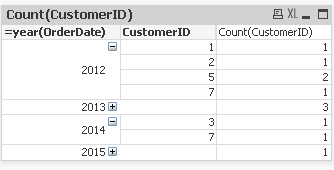Unlock a world of possibilities! Login now and discover the exclusive benefits awaiting you.
- Qlik Community
- :
- All Forums
- :
- QlikView App Dev
- :
- Re: counting returning customers
- Subscribe to RSS Feed
- Mark Topic as New
- Mark Topic as Read
- Float this Topic for Current User
- Bookmark
- Subscribe
- Mute
- Printer Friendly Page
- Mark as New
- Bookmark
- Subscribe
- Mute
- Subscribe to RSS Feed
- Permalink
- Report Inappropriate Content
counting returning customers
Hi
I have a list of customers and each customers orderDates. I'm trying to count the number of customers who have made orders the following years.
Of the 4 customers who have made orders in 2012, 2 of 4 have also ordered in 2013 and 1 of 4 have one in 2014.
How can this be made?
Thanks
| CustomerID | OrderDate |
|---|---|
1 | 12-12-2012 |
| 2 | 01-01-2012 |
| 2 | 05-05-2013 |
| 3 | 07-07-2014 |
| 4 | 06-06-2015 |
| 5 | 04-04-2012 |
| 5 | 04-04-2012 |
| 6 | 08-08-2013 |
| 7 | 01-01-2012 |
| 7 | 01-01-2013 |
| 7 | 01-01-2014 |
Accepted Solutions
- Mark as New
- Bookmark
- Subscribe
- Mute
- Subscribe to RSS Feed
- Permalink
- Report Inappropriate Content
Load *,Year(OrderDate) As Yr;
Load CustomerID,Date#(OrderDate,'MM-DD-YYYY') As OrderDate Inline [
CustomerID,OrderDate
1,12-12-2012
2,01-01-2012
2,05-05-2013
3,07-07-2014
4,06-06-2015
5,04-04-2012
5,04-04-2012
6,08-08-2013
7,01-01-2012
7,01-01-2013
7,01-01-2014 ];
='Returing customers in 2013: ' &Count(DISTINCT {<CustomerID=P({<Yr={'<2013'}>})>*<CustomerID=P({<Yr={2013}>})>}CustomerID)
='Returing customers in 2014: ' &Count(DISTINCT {<CustomerID=P({<Yr={'<2013'}>})>*<CustomerID=P({<Yr={2014}>})>}CustomerID)
- Mark as New
- Bookmark
- Subscribe
- Mute
- Subscribe to RSS Feed
- Permalink
- Report Inappropriate Content
You can add a Year field to your table and present in a pivot table
- Mark as New
- Bookmark
- Subscribe
- Mute
- Subscribe to RSS Feed
- Permalink
- Report Inappropriate Content
Load *,Year(OrderDate) As Yr;
Load CustomerID,Date#(OrderDate,'MM-DD-YYYY') As OrderDate Inline [
CustomerID,OrderDate
1,12-12-2012
2,01-01-2012
2,05-05-2013
3,07-07-2014
4,06-06-2015
5,04-04-2012
5,04-04-2012
6,08-08-2013
7,01-01-2012
7,01-01-2013
7,01-01-2014 ];
='Returing customers in 2013: ' &Count(DISTINCT {<CustomerID=P({<Yr={'<2013'}>})>*<CustomerID=P({<Yr={2013}>})>}CustomerID)
='Returing customers in 2014: ' &Count(DISTINCT {<CustomerID=P({<Yr={'<2013'}>})>*<CustomerID=P({<Yr={2014}>})>}CustomerID)
- Mark as New
- Bookmark
- Subscribe
- Mute
- Subscribe to RSS Feed
- Permalink
- Report Inappropriate Content
As Jonathan suggested you can use Year as dimension in a pivot table like below.

here you can find number of orders by year and again you can go to the second dimension to find who all have ordered in a particular year.
- Mark as New
- Bookmark
- Subscribe
- Mute
- Subscribe to RSS Feed
- Permalink
- Report Inappropriate Content
If you want to do it in the script, you can add this resident load after you load the Orders table (you may have named it differently).
It will create a linked table with for each customerID:
ReturnedTimeSpan: diff between first and last order year
ReturnedYears: number of distinct years the customer has ordered
I'm sure you can do more according to what you really want with this as starting point.
Returning:
Load
CustomerID,
Max(Year(OrderDate)) - Min(Year(OrderDate)) As ReturnedTimeSpan,
Count(DISTINCT Year(OrderDate)) As ReturnedYears
RESIDENT Orders GROUP BY CustomerID;